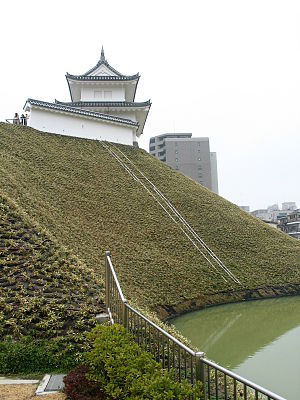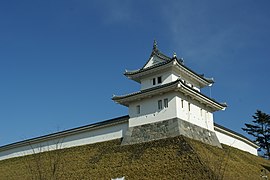Utsunomiya Castle
| Utsunomiya Castle | ||
|---|---|---|
|
Utsunomiya Castle |
||
| Creation time : | 1063? | |
| Castle type : | Hirajiro (Lower Castle) | |
| Conservation status: | Hommaru partially reconstructed | |
| Place: | Utsunomiya | |
| Geographical location | 36 ° 33 '16 " N , 139 ° 53' 9" E | |
|
|
||
The castle Utsunomiya ( Jap. 宇都宮城 , Utsunomiya-jō ) is located in the city of Utsunomiya , Tochigi Prefecture . In the Edo period , ten medium-sized Fudai daimyo resided there one after the other , most recently a branch of the Toda with an income of 70,000 koku .
Lords of the castle in the Edo period
- From 1601 Okudaira Iemasa (1577-1614) with an income of 100,000 koku.
- From 1619 a branch of the Honda with 155,000 Koku.
- From 1621 a branch of Okudaira with 120,000 koku.
- From 1668 a branch of the Matsudaira (Okudaira) with 150,000 koku.
- From 1681 a branch of the Honda with 100,000 Koku.
- From 1685 a branch of Okudaira with 90,000 koku.
- From 1697 a branch of the Abe with 100,000 Koku.
- From 1710 a branch of Toda with 67,000 Koku.
- From 1749 the Matsudaira (Fukōzu) with 65,000 Koku.
- From 1774 a branch of Toda with 77,000 Koku.
history
The castle is said to have been built in 1063 by the ancestor of the Utsunomiya , Fujiwara no Sōen. The Utsunomiya remain lords of the castle until 1597, when the then lord of the castle Utsunomiya Kunitsuna lost his domain and the history of this family ended.
The castle town of Utsunomiya was bounded in the east by the Tagawa River ( 田 川 ), and the castle was situated on a hill extending from north to south. In the middle was the heart-shaped central area, the hommaru, which was surrounded by a moat. Surrounded by the Ni-no-maru ( 二 の 丸 ), San-no-maru ( 三 の 丸 ) and the Sotokuruwa ( 外 曲 輪 ), which were also separated by moats, the castle was triple protected. The castle had almost exclusively earth walls, only the eastern part of the Hommaru and the gates were protected by walls. In the north, the castle had the Maru-umadashi ( 丸 馬 出 し ), which together with the moat Mikazuki-bori ( 三 日月 堀 ) formed a special gate system in the Koguchi style.
At the time when Honda Masayumi (1565–1637) was lord of the castle, there is said to have been a castle tower, in the Edo period the Hommaru was only protected by five watchtowers, the watchtower on the particularly high northwest corner, the Seimei watchtower ( 清明櫓 , Seimei-yagura ), took over the function of a castle tower. The residence in Hommaru existed until the first third of the 18th century. The main residence in Ni-no-maru burned down in 1683 but was rebuilt.
In April 1868, the Bakufu troops defending themselves in the castle were attacked. Half the city was destroyed during the conquest. Today almost the entire castle area has become urban area, only the western part of the Hommaru is still there and is part of a park. In recent years, part of the Hommaru fortification with two watchtowers, the Seimei watchtower and the Fujimi watchtower ( 富士 見 櫓 , Fujimi-yagura ) on the southwest corner, has been rebuilt. There is also a small museum about the history of the castle, the Seimei-kan ( 清明 館 ).
photos
Remarks
- ↑ Koguchi ( 虎口 ), literally "tiger's mouth" is a special form of a gate system of a Japanese castle.
- ↑ A temporary residence was built in Hommaru around 1850 for the 12th Shogun Tokugawa Ieyoshi , who was on the way to Nikkō .
literature
- Sugai, Yasuo: Utsunomiya-jo in: Miura, Masayuki (Ed.): Shiro to jinya. Tokoku-hen, p. 56. Gakken, 2006. ISBN 978-4-05-604378-5 .




